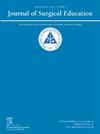Utilizing the DiSC Assessment in Surgical Residency Leadership Training to Address Communication Skill Acquisition: A Kern Six-step Approach to Curriculum Development
IF 2.6
3区 医学
Q1 EDUCATION, SCIENTIFIC DISCIPLINES
引用次数: 0
Abstract
Objective
Effective communication is essential in delivering high-quality patient care, and in recent years, resident education has expanded to focus on nontechnical skills and communication training. The “Everything DiSC” model is a communication inventory tool used to help employers and employees gain insight into how an individual may communicate within a team and how others may perceive similarities and differences in communication styles, comprising of Dominance (D), Influence (i), Steadiness (S), and Conscientiousness (C). In this report, we describe our experience mapping the DiSC model to the Kern 6-step framework for curriculum development and summarize residents’ feedback several years following its implementation.
Design
A general needs assessment was conducted to identify the problem of a lack of a formalized communication and leadership education and performed a general needs assessment. A curriculum was developed for a single academic surgical residency program to address development of nontechnical skills. We designed the leadership curriculum to be given over 4 sessions, with topics including from leadership styles, working within groups, feedback, and wellness. We utilized the DiSC tool, which is a 79-question survey, to establish communication styles of each of our residents and to determine the DiSC style.
Setting
This study was conducted at a single academic institution within a surgical residency training program.
Participants
This study included surgical residents at a single academic surgical training program.
Results
The initial needs assessment survey was completed by 28 of 36 residents, with all residents surveyed (100%) agreeing that communication training was important. In contrast, only 21% agreed that they had received adequate training on communication during residency. 28 residents completed the DiSC Year-in-Review Survey, which indicated that overall, the residents felt that DiSC was useful throughout the year. The majority of residents listed learning and understanding other people's communication style as what they appreciated most about the DiSC sessions.
Conclusions
The inclusion of behavioral assessment tools within surgical residency education can provide an opportunity for residents to evaluate their communication techniques and provide a gained awareness across various settings. Continued focus on communication skills, such as with the use of the DiSC model, can enhance patient care at any institution providing such training. This leadership curriculum aided our surgical residency program and can likely facilitate similar value within other training institutions.
利用DiSC评估在外科住院医师领导训练中解决沟通技巧习得:Kern课程开发的六步方法。
目的:有效的沟通是提供高质量患者护理的关键,近年来,住院医师教育已经扩展到非技术技能和沟通培训。“Everything DiSC”模型是一种沟通清单工具,用于帮助雇主和员工深入了解个人在团队中的沟通方式,以及其他人如何看待沟通风格的异同,包括支配(D),影响力(i),稳定性(S)和责任心(C)。在本报告中,我们描述了将DiSC模型映射到Kern六步课程开发框架的经验,并总结了实施后几年居民的反馈。设计:进行一般需求评估,以确定缺乏正式沟通和领导力教育的问题,并进行一般需求评估。一个课程是为一个单一的学术外科住院医师项目开发的,以解决非技术技能的发展。我们设计的领导力课程分为四节课,主题包括领导风格、团队合作、反馈和健康。我们使用DiSC工具,这是一个79个问题的调查,建立每个居民的沟通风格,并确定DiSC风格。背景:本研究是在外科住院医师培训计划的单一学术机构进行的。参与者:本研究包括参加单一学术外科培训项目的外科住院医师。结果:36名住院医生中有28名完成了初步需求评估调查,所有接受调查的住院医生(100%)都认为沟通培训很重要。相比之下,只有21%的人认为他们在住院期间接受了足够的沟通培训。28位居民完成了年度回顾调查。调查结果显示,总体而言,居民认为全年都有用。大多数住院医生认为学习和理解他人的沟通方式是他们对DiSC课程最欣赏的地方。结论:在外科住院医师教育中纳入行为评估工具可以为住院医师提供一个评估他们沟通技巧的机会,并提供在各种情况下获得的意识。继续注重沟通技巧,例如使用DiSC模式,可以改善任何提供此类培训的机构对病人的护理。这个领导力课程帮助了我们的外科住院医师项目,并可能在其他培训机构中促进类似的价值。
本文章由计算机程序翻译,如有差异,请以英文原文为准。
求助全文
约1分钟内获得全文
求助全文
来源期刊

Journal of Surgical Education
EDUCATION, SCIENTIFIC DISCIPLINES-SURGERY
CiteScore
5.60
自引率
10.30%
发文量
261
审稿时长
48 days
期刊介绍:
The Journal of Surgical Education (JSE) is dedicated to advancing the field of surgical education through original research. The journal publishes research articles in all surgical disciplines on topics relative to the education of surgical students, residents, and fellows, as well as practicing surgeons. Our readers look to JSE for timely, innovative research findings from the international surgical education community. As the official journal of the Association of Program Directors in Surgery (APDS), JSE publishes the proceedings of the annual APDS meeting held during Surgery Education Week.
 求助内容:
求助内容: 应助结果提醒方式:
应助结果提醒方式:


